IN MEMORIAM
Witness to our fidelity to the Church
Henri Bachelet Honorary Canon of the Choir
of Notre-Dame Cathedral, Paris
(1922-2023)
ON the morning of June 14, 2023, Canon Henri Bachelet passed away in the peace of the Lord, in the arms of the Immaculate Conception, in his 102nd year at Maison Marie-Thérèse, a retirement home for priests in the diocese of Paris. He was born in Paris on May 11, 1922 to deeply Catholic parents, of whom he was very proud.
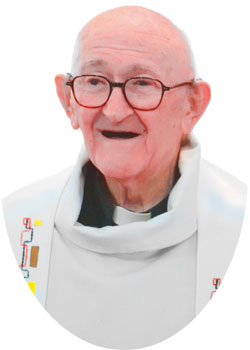 His mother, Cécile, née Pestel, the youngest of three children, was born into a very musical family, after Marie (who became Sister Cécile in religion), pianist and organist in her community of the Sisters of Saint Charles of Nancy, and Mathilde (a war widow whose husband was killed in action on January 12, 1915 at Crouy, near Soissons, after barely a year and a half of marriage), who gave violin lessons. Cécile also played the violin and piano and taught them to her children.
His mother, Cécile, née Pestel, the youngest of three children, was born into a very musical family, after Marie (who became Sister Cécile in religion), pianist and organist in her community of the Sisters of Saint Charles of Nancy, and Mathilde (a war widow whose husband was killed in action on January 12, 1915 at Crouy, near Soissons, after barely a year and a half of marriage), who gave violin lessons. Cécile also played the violin and piano and taught them to her children.
Cécile met her future husband thanks to her father’s violin lessons. Édouard Pestel taught violin at the Vincent Dindy Schola Cantorum, and Eugène Bachelet, the son of one of Édouard’s friends, used to come to the Pestel’s home for violin lessons before the war. Then came the First World War, and this young man was soon taken prisoner and spent the whole war in Germany. He was nevertheless sentenced to death for having beaten a German soldier who was mistreating a French prisoner, something that he was unable to tolerate. The end of the war saved him, and on his return from captivity, Eugène Bachelet became engaged to Cécile. Their wedding took place on July 28, 1921 in Paris.
Eugène was a civil servant with the Paris gas company. Very devoted to the Church, he began studying Gregorian chant under the guidance of Mr. Le Guennant in 1938-39, to become a cantor as part of the liturgical renewal initiated by Saint Pius X. He then became head altar server of Notre-Dame de Paris in the early 1950s, organising the altar boy service and helping the chapter of canons in every way.
Eugène was also a member of Action Française and a Camelot du Roi between the two World Wars. The family therefore had strong reactionary convictions. Henri would bear this stamp throughout his life and remained deeply Catholic. He possessed the spirit of the Church to a high degree, was neither democrat nor republican, and even less Gaullist.
Henri was the eldest of one brother and five sisters, a large family that he greatly loved. He had a happy childhood, with a strict but not straitlaced upbringing. Playing music was a family activity. Dad played the viola, Mum the piano, and the children gradually joined the orchestra: piano, violin, cello, clarinet, flute, and so on. They sang at the dinner table and in the living room for family concerts, in Saint-Georges’ church in Paris for Midnight Mass, and even every Sunday during the holidays in Sammeron, the village where the family had a country home near La Ferté-sous-Jouarre, to the delight of the parishioners and the parish priest. Simple Masses, with either Gregorian chant or canticles under the direction of Dad, accompanied on the harmonium by Mum, sung by the whole congregation, and as the years went by, soon as a four part mixed choir. Vespers and Benediction of the Blessed Sacrament on feast days. Family holidays were joyful, everything becoming an occasion for funny stories that would be told to the younger generations, just as grandfather Édouard Pestel used to tell his own, and which would still make us laugh decades later. Perhaps we were not mystics nor demonstratively pious; we were simply French Catholics.
THE WAR.
In October 1939, the family moved to Orleans, in anticipation of the defeat to come after a phoney war. Henri was 17 years old. He started a diary in which he noted the progression on the fronts in the various countries at war, as he was able to follow it on the radio or in the newspapers, and the reflections of his parents’ comments:
June 2, 1940 [in the midst of the French debacle]: “Dad arrived in Orleans this morning by train [from Paris].
“According to Dad, we were had in Belgium [...]. It is unfortunate, but we have no energy, the government always lets itself be outdone by the others. We are invariably like the Carabinieri: we arrive too late. And why is that?
“Firstly, because in the government, there is no single person who manages the affairs of state. They always have to confer; that wastes time, no agreement is reached. The result is that no decisions are taken and we end up in our present situation.
“Whose fault is it? The person who is governing. Who is governing? All the French. Everyone is in charge, but no one is responsible. It is chaos. After that, we should not be surprised if we fail everywhere and always.
“If, in 1919, we had wanted to make a peace other than the one that was negotiated, if Foch had had the courage to twist the deputies around his little finger [against Clemenceau’s betrayal during the peace treaty negotiations], we would be able to sleep in peace.
“Foch did not want to do it, and the French are too stupid to do it, especially Catholics.”
June 8, 1940, in the midst of the French exodus. A retreating French column had picked up the mother and her seven children outside Orleans, while Dad had stayed behind, lost in the crowd of refugees. They arrived at the Château de Rocreuse (Vienne). The soldiers, thinking that the family would be well there, left them: “Mum had made arrangements with the steward. She had noticed a portrait of the Duc de Guise. She told the steward and he immediately took her to the baron, who like the steward, was a member of Action Française. So the Baron gave us mattresses and a few saucepans” and lodged this mother alone with her seven children in a small house on his estate.
August 12, 1941: “Marshal Pétain gave a radio address to the French people in which he announced his programme: in particular, that he would abolish the parliamentary allowance, hunt down the F.M., the Communists and unethical civil servants. He expressed his desire to return to Paris and to see the prisoners again. His speech was, so to speak, an admonition to those French who did not want to follow the Marshal’s government.”
In April 1943, things became more difficult for Henri. He was called up for the STO, and his transfer order for Germany had even been stamped. Thanks to his father’s skill, who went in person to the kommandantur, to the advice of priests close to the family and their contacts within the Ministry of Agriculture, Henri passed the entrance exam for a dairy institute in Sugères in Auvergne, and so obtained a reprieve just in time, negotiated between the Ministry and the occupying forces. Passive resistance!
May 2, 1944: “Isn’t it from among the finest clique that France harboured before the war that Monsieur de Gaulle chooses his ministers: Marty, Vincent Auriol, Granier, etc., that he formed the Liberation Committee? Father Maritain (of the Catholic Church, if you please) believes that all the French want to have the Fourth Republic (which would be a slightly reworked Third Republic).
“The intrusion of the Russians into the affairs of the Algiers committee is such that one wonders if de Gaulle is not Stalin’s valet.”
August 11, 1944: “After having endured the war, then the occupation, we are going to have to endure the ‘liberation’.”
Thus the war ended for the family, not without a bombing raid on their holiday home on Sunday afternoon August 27, 1944. The bombs were American!
SERVING THE CHURCH.
After passing his first diploma as a milk and butter inspector in November 1944, he completed his training from January to October 1945 at the École d’industrie laitière [Dairy Industry School] in Aurillac. He then got a job in the Meuse Department, then in the city of Longwy, and he finally returned to Paris in March 1948, again working in a dairy, then in the hevea milk industry from September on, in the 8th arrondissement. This return home gave him the opportunity to take courses at the Institut grégorien de Paris, which was still directed by Monsieur Le Guennant, where he received good marks.
The Lord, however, was calling him. We know little to nothing about the awakening of his vocation as a priest. He was very discreet. Simplicity was the hallmark of this vocation. In October 1950, much to his parents’ delight, he entered the seminary at Issy-les-Moulineaux in Paris as a late vocation, leaving behind his job and a fiancée. At the seminary, he had most of the same teachers as our Father had some two years earlier. Years later, when Father Henri Bachelet read Memoirs and Anecdotes, volume 2, he found the atmosphere of the seminary exactly as he had known it: studious, religious, regular. He took part in the beautiful liturgies, having been appointed choirmaster for the seminarians because of his musical talents. He was ordained a priest by Cardinal Feltin on the feast of Saints Peter and Paul on June 29, 1955, along with twenty-five other confreres for the diocese of Paris.
His first ministry was at Collège Stanislas which, at the time, was run entirely by clerics. He was prefect of the fifth year and then the second year in 1958. However, he was drawn towards parish ministry and asked to be transferred to a parish. On January 1, 1962, he was appointed curate at Saint-Antoine des Quinze-Vingts. He remained there until September 1978, carrying out a curate’s ministry for sixteen years in this parish, which includes the Paris morgue. He celebrated many funerals – more than two thousand – sometimes in epic contexts. For instance, on one occasion the undertakers brought in the coffin and then withdrew, leaving only the deceased himself to attend. The funeral service was held, but there was no sermon that day! Those were the happy times when everyone inevitably passed through the Church!
There were also catechism classes. Throughout his life, Father Bachelet enjoyed teaching catechism to children. He took advantage of a pilgrimage to the Holy Land to take a large number of photographs to illustrate the Gospel stories in his catechism classes, not to mention filmstrips.
During this period, he took a keen interest in the history of the Quinze-Vingts district, and organised various exhibitions for the parish, on the history of the Bastille, Saint Anthony the Hermit church, Saint Vincent de Paul and Paris.
These, however, were the years of the conciliar revolution; there were revolutions in the liturgy and in pastoral ministry that greatly affected him. “We can no longer do anything except with senior citizens,” he confided to a parishioner at the time.
In 1973, one of his fellow curates at Saint-Antoine, his friend Father Robert Mottier, spoke to him about Father de Nantes and his Book of Accusation against Paul VI. At his instigation, Father Henri Bachelet enrolled in the ranks of the Roman Legion. The members united themselves with Father de Nantes in depositing in Rome this Book of Accusation against Paul VI for heresy, schism and scandal, asking Pope Paul VI himself to judge in his own cause through the exercise of his solemn and infallible Magisterium. This was his first indirect contact with the Catholic Counter-Reformation.
In 1978, Father Bachelet was appointed curate at Sainte-Hélène’s, then in 1984, his last appointment, curate at Saint-Laurent’s. He remained there until September 2004, when he entered Maison Marie-Thérèse, the diocesan residence for retired priests. He was then eighty-two years old.
Called to serve the Church since 1955, he served it in a ministry without ambition. He was a curate all his life. He was exactly what our father admiringly called “the infantry of the Church”, carrying out his ministry without glory, but scrupulously and dedicatedly. One day, when his motorbike was stopped at a red light on a Parisian thoroughfare, a young man also on a motorbike saw his Roman collar and asked him: “Are you a priest?” “Yes, I’m a priest.” “Can you hear my confession?” There and then, a little way back from the kerb, he reconciled this prodigal son, with no human respect. How many others did he reconcile during his ministry in a similar way?
He fulfilled his duty in all things, despite his disagreement with certain trends. His heart was rather traditional, through family heritage, and he loved beautiful liturgy and sacred music. He nevertheless accepted all the reforms without question, with regret but without bitterness. Later, he would point out the disastrous results of what had been presented to him as a new, more effective pastoral approach.
He did not have the talent for spectacular preaching, but with his magnificent voice, he made up for it with the choir, which is another kind of preaching. “The choir,” he wrote to me, “helps the parishioners to participate well at Mass.” So he always put together and directed the choirs of his successive parishes, leaving unforgettable memories of beautiful liturgies everywhere. All the while, he continued to look after his many nieces and nephews, whom, of course, he taught to sing!
He was perfectly a member of the clergy, at one with the ecclesiastical establishment with a sort of nobility and dignity inherited from his Sulpician masters. For everyone, the office of canon that he received at the beginning of his retirement, on May 13, 2005, seemed to fit perfectly with the model of priest that he embodied: unpretentious, a man of duty and fidelity, attached to his ministry and respectful of authority, for better or for worse. Witness that fact that he faithfully recited his breviary even when his eyesight began to fail him. He was keen on it; it had become his duty as a canon and it was his prayer for the diocese of Paris.
CANON BACHELET’S SECRET.
Since 1996, when his sister Marie-Thérèse and brother-in-law Eugène Sady moved to Palis, closer to Maison Saint-Joseph, he was happy to come there on August 15 every year to attend the procession to honour the Blessed Virgin, in fulfilment of “King Louis XIII’s Vow.” After the procession, our Father, Georges de Nantes, liked to talk with this Parisian confrere. It is fortunate that this relationship was established through the Blessed Virgin. However, despite the entreaties of his sister, Françoise – or perhaps because of them – he remained rather reserved. For him, a full-fledged member of the ecclesiastical establishment and vicar in a large parish in Paris, our ecclesiastical situation was not clear.
His retirement, in October 2004, coincided with the time when our Father was no longer able to continue saying Mass, and no confrere was able to provide this service at Maison Saint-Joseph. He then responded with boundless dedication to our requests to come and give us the Sacraments. This was a new phase in his ministry that lasted sixteen years. It had a profound effect on him. Even though, at his age, these travels were particularly tiring (they led him to several pilgrimages to Lourdes, Fatima and as far away as Canada), he never refused. This initial charitable disposition was his gateway to knowing our community intimately. It was not an enthrallment, not love at first sight, not even an intellectual conviction, as it had been for his little sister Françoise.
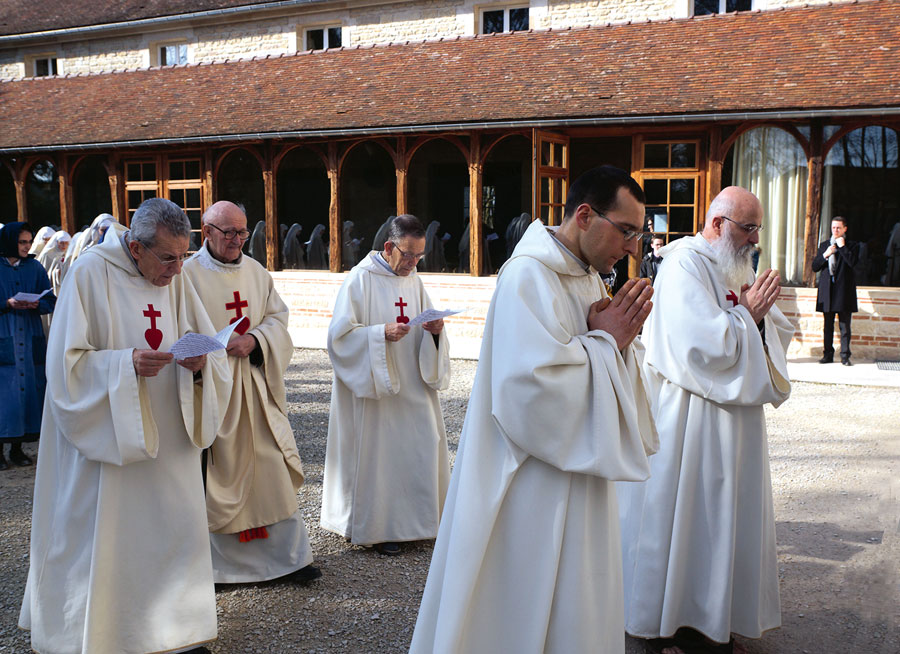
Little by little, he discovered our life, our combats, our difficulties, our convictions, which matched his own and those of his family’s tradition summed up in the doctrines of Action Française and integral Catholicism. Each visit was an opportunity for him to get to know Father de Nantes better, because in the spare time that his ministry left him, he listened to lectures or read the Catholic Counter-Reformation. In 2005 and 2006, after listening to a retreat on Saint Paul preached by Father de Nantes in the early 1980s, he told me: “Father de Nantes is the greatest theologian of the 20th century!” Hence, he regarded criticism against our Father as the jealousy of lesser men.
What struck him were the fruits of this work to which he was devoting himself. The families in particular delighted him. He loved to see so many children attending our ceremonies, praying, then afterwards, running about. “When I go to Saint-Parres, I feel like part of the family,” he once confessed to his audience.
A Phalangist friend recalls: “I remember the first times when he came to the Maison Saint-Joseph. The brothers asked me to go fetch him at Maison Marie-Thérèse and drive him to Saint-Parres. This was a few months before he attended his first Phalangist Summer Camp in August [2007].
“It seems to me that he hadn’t yet fully understood what the Catholic Counter-Reformation was and he was still quite influenced by what he was hearing on Radio Courtoisie .
“But when I saw him a few months later at the end of the camp, I was amazed at his enthusiasm and his understanding of the lectures, which he summed up as though they had been his life-long convictions, especially the one that explained the crisis of the Church as being the result of the Second Vatican Council. A few months earlier in the car, he had given me, with conviction, a different explanation.
“I was truly in awe of his modesty and the work of God’s grace in his soul, to say nothing, of course, of the role played by the affection of his nephews in the Community and the other brothers!”
That Phalange camp in 2007, the first of the fourteen he attended as chaplain, on the subject of “Vatican II: auto-da-fé”, was a decisive turning point in his understanding of the Catholic Counter-Reformation. He asked for the texts of the conferences so that he could read them in depth and really understand this formidable reformation that he had witnessed first-hand in his parish ministry. The reform of the catechism, the disaster of the modern liturgy, to which he was very sensitive. He would say to anyone who would listen to him: “We did away with Latin to get people to church, to have greater attendance, and here is the result: we emptied the churches.” No, he did not appreciate those “chatter Masses”, as he put it, where the priest feels obliged to talk constantly, whereas the liturgy is an act of worship and prayer performed by the Church, behind which man disappears, leaving only the priest of the Church to be seen. He knew how to celebrate Mass so well!
When he realised the harmful nature of the Council, he admired Father de Nantes immensely for having foreseen this collapse of the Church, which he had seen all too well. “Father de Nantes?” he said to our Brother Francis, “I see him as one of the just men of the Old Testament. He is a prophet; everything he announced has come to pass.”
Submission to the Pope was also an important question for him. How could he, a simple curate who had always been obedient, give such support to our Community, considered by many to be at odds with the Church? The charity of his ministry, also his great modesty, led him to understand that this ecclesial situation, extraordinary to say the least, was nevertheless so just. Father de Nantes’ rejection of the conciliar reformation, far from the excesses of the integrist schism, had nothing to do with rebellion, since it was part and parcel of a tradition to which Canon Bachelet’s heart was attached. Indeed, it was none other than the religion in which he had grown up and been ordained. It was not a question of rite or methods, but of having the same Faith, the same doctrine, the same heart, the same Catholic charity, all of which the Council called into question.
He was a witness to the whole evolution of the Church, because he had meekly participated in it. Yet his assessment in the autumn of his life was harsh. The fruits of the Council? He studied the Council a great deal during his retirement, reading and re-reading our Father’s last book, Auto-da-fé. It was the last book he read, perhaps for the fourth time, as he approached his hundredth birthday.
He was very concerned when the hierarchy asked questions about our submission to the Magisterium. He was, however, indignant at the cavalier or contemptuous way in which Brother Bruno’s reply was met with silence. “The bishops fear you!” he told Brother Bruno. Attentive to the intellectual soundness of arguments, he recognised the full legitimacy of our Father’s doctrine and works.
When a man is over ninety years of age, he no longer has much to learn and it becomes difficult to enthral him. This was not his case, and it was not the least of his virtues: with an incredible youthful spirit, he was passionate about the studies of our Father and the brothers; Brother Henry’s oratorios set the seal on his attachment to Our Lady of Fatima. With his legendary cheerfulness, he knew how to liven up entertainment gatherings with his piano performances, his songs and his hilarious sketches, both with his confreres at Maison Marie-Thérèse and with the young people at our camps. He was also very attached to his privilege as Canon of the Cathedral of Paris, of presenting the Crown of Thorns to the veneration of pilgrims.
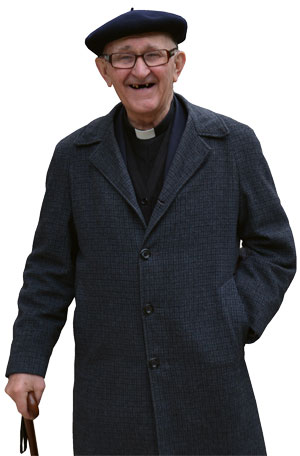 In February 2010, Canon Bachelet was providentially at Maison Saint-Joseph at a time when our Father’s health was in a critical state. He administered him the Last Rites for the final time. The following week, he was once again there to say Mass for us and to administer the Precious Blood as Holy Viaticum to our Father who was on the threshold of his agony. He attended the prayers for the dying with the whole community and gave the apostolic blessing in articulo mortis. It was a touching act of Providence that allowed the maternal Church to be at the bedside of our beloved Father. The next day, as soon as he woke up, Canon Bachelet was eager to recollect himself before his confrere who had just died in the early hours of the morning. He was very impressed and moved. At the end of the morning, he celebrated the first Mass in the presence of his body that was lying in state in our chapel. Before returning to the sacristy, he paid his respects to the man whom he considered an incomparable servant of the Church.
In February 2010, Canon Bachelet was providentially at Maison Saint-Joseph at a time when our Father’s health was in a critical state. He administered him the Last Rites for the final time. The following week, he was once again there to say Mass for us and to administer the Precious Blood as Holy Viaticum to our Father who was on the threshold of his agony. He attended the prayers for the dying with the whole community and gave the apostolic blessing in articulo mortis. It was a touching act of Providence that allowed the maternal Church to be at the bedside of our beloved Father. The next day, as soon as he woke up, Canon Bachelet was eager to recollect himself before his confrere who had just died in the early hours of the morning. He was very impressed and moved. At the end of the morning, he celebrated the first Mass in the presence of his body that was lying in state in our chapel. Before returning to the sacristy, he paid his respects to the man whom he considered an incomparable servant of the Church.
The very end of Canon Bachelet’s life was a trying time for him, as he could no longer see or hear well. Yet he always said “Thank you” for everything to everyone. He prayed often. Last June 1, when I took him to the hearing aid specialist, after a while, no know longer realising where he was, feeling the cool, silent atmosphere, he asked me if we were in the chapel. He did not understand my answer, so he made a big sign of the cross, which he did so well, and started reciting the Rosary. That was all he had left, and that was the main thing. There can be no doubt that it was the Blessed Virgin who came to fetch him, without disturbing anyone, between two rounds of the nurses who were watching over him, on the morning of June 14. “Come, good and faithful servant, you have been faithful in little things; enter into the joy of your Lord.”
Brother Sebastian of the Heart of Mary Immaculate
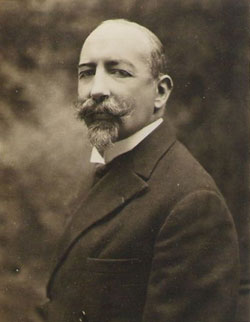
Jean d’Orléans (1874-1940), Duc de Guise, pretender to the throne of France, and father of the Count of Paris. He was of the Orleans branch, and Action Française recognised him as the heir to the crown of France. The presence of the Duc’s photo indicated to Madame Bachelet that the inhabitants of the Château were like-minded people.
STO: abbreviation of Service du travail obligatoire = Compulsory Labour Service established in occupied France in 1943 during the Second World War to provide French workers to German factories.
Memoirs and Anecdotes are autobiographical writings of our Father, Volume 1 relates his childhood, and Volume 2, his seminary studies.
Radio Courtoisie is a French community radio station based in Paris. It made its first live broadcast in November 1987 and is now broadcast nationwide. It is aimed primarily at conservative, traditionalist and nationalist listeners. Its programmes focus on culture, politics, history and traditional values. The station is also known for its controversial editorial line, reinforcing the views of its more conservative listeners, which sets it apart from most other radio stations. As this radio station refuses to accept any advertising resources, it claims to be totally independent. Unfortunately, this reactionary radio station has no solid doctrinal foundation: it denounces certain evils in our society, but without going back to the real causes: Luther's Reformation of 1517, the French Revolution and the Second Vatican Council, nor does it condemn the cult of modern man.
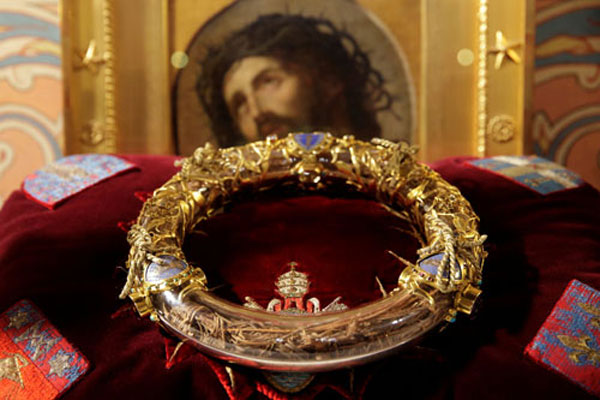
Accounts of the Crown of Thorns date back to the 4th century and in 409 Saint Paulinus mentions it being kept in a basilica in Jerusalem, then in 570 it is documented that the Crown of Thorns was exhibited for veneration at another basilica.
Over the centuries many relics including the Crown of Thorns were moved to the Byzantine Emperors’ chapel in Constantinople.
Emperor Baldwin II, being in great financial difficulties pawned the Crown of Thorns along with other relics to a Venetian Merchant Bank in 1238 so that he could obtain credit, and then Saint Louis, who was King Louis IX of France took over the relics and paid back the Venetians.
Saint Louis IX went to Villeneuve-l’Archevêque in the Burgundy region of France to take possession of the relics on August 10, 1239 and then led the procession towards their final destination of Paris. When the relics arrived in Paris, Saint Louis took off his royal attire and wearing only a simple tunic, with bare feet, he carried the Crown of Thorns in procession to the Notre Dame de Paris Cathedral where it was venerated whilst the Sainte Chapelle chapel was being built as a reliquary for it and the other relics of Our Lord’s Passion.
During the French Revolution, these precious Relics were hidden. When then were finally given back to the Archbishop of Paris on August 10, 1806, he placed them within the Treasury of the Notre Dame Cathedral, where they have remained ever since.
The Crown of Thorns, conserved by the Canons of the Metropolitan Basilica Chapter and guarded by the Knights of the Order of the Holy Sepulchre of Jerusalem, is presented by the Canons for veneration on the first Friday of each month in addition to every Friday during Lent, and above all on Good Friday. With great piety, Canon Bachelet took his turn at presenting the Crown of Thorns for veneration.